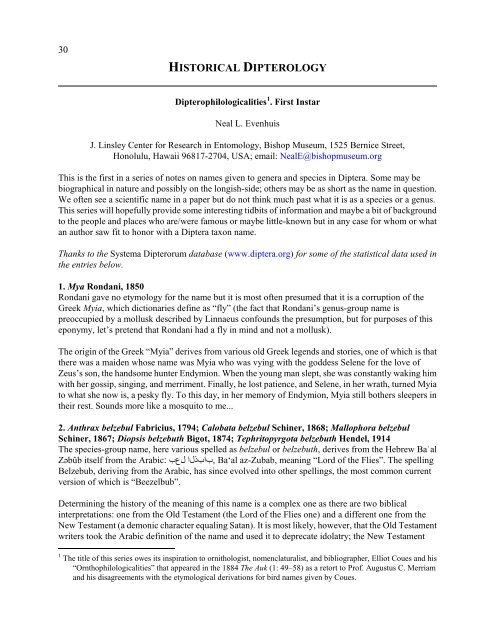Fly Times Issue 48, April 2012 - North American Dipterists Society
Fly Times Issue 48, April 2012 - North American Dipterists Society
Fly Times Issue 48, April 2012 - North American Dipterists Society
Create successful ePaper yourself
Turn your PDF publications into a flip-book with our unique Google optimized e-Paper software.
30<br />
HISTORICAL DIPTEROLOGY<br />
Dipterophilologicalities 1 . First Instar<br />
Neal L. Evenhuis<br />
J. Linsley Center for Research in Entomology, Bishop Museum, 1525 Bernice Street,<br />
Honolulu, Hawaii 96817-2704, USA; email: NealE@bishopmuseum.org<br />
This is the first in a series of notes on names given to genera and species in Diptera. Some may be<br />
biographical in nature and possibly on the longish-side; others may be as short as the name in question.<br />
We often see a scientific name in a paper but do not think much past what it is as a species or a genus.<br />
This series will hopefully provide some interesting tidbits of information and maybe a bit of background<br />
to the people and places who are/were famous or maybe little-known but in any case for whom or what<br />
an author saw fit to honor with a Diptera taxon name.<br />
Thanks to the Systema Dipterorum database (www.diptera.org) for some of the statistical data used in<br />
the entries below.<br />
1. Mya Rondani, 1850<br />
Rondani gave no etymology for the name but it is most often presumed that it is a corruption of the<br />
Greek Myia, which dictionaries define as “fly” (the fact that Rondani’s genus-group name is<br />
preoccupied by a mollusk described by Linnaeus confounds the presumption, but for purposes of this<br />
eponymy, let’s pretend that Rondani had a fly in mind and not a mollusk).<br />
The origin of the Greek “Myia” derives from various old Greek legends and stories, one of which is that<br />
there was a maiden whose name was Myia who was vying with the goddess Selene for the love of<br />
Zeus’s son, the handsome hunter Endymion. When the young man slept, she was constantly waking him<br />
with her gossip, singing, and merriment. Finally, he lost patience, and Selene, in her wrath, turned Myia<br />
to what she now is, a pesky fly. To this day, in her memory of Endymion, Myia still bothers sleepers in<br />
their rest. Sounds more like a mosquito to me...<br />
2. Anthrax belzebul Fabricius, 1794; Calobata belzebul Schiner, 1868; Mallophora belzebul<br />
Schiner, 1867; Diopsis belzebuth Bigot, 1874; Tephritopyrgota belzebuth Hendel, 1914<br />
The species-group name, here various spelled as belzebul or belzebuth, derives from the Hebrew Baʿal<br />
Zəbûb itself from the Arabic: بابذلا لعب , Ba‘al az-Zubab, meaning “Lord of the Flies”. The spelling<br />
Belzebub, deriving from the Arabic, has since evolved into other spellings, the most common current<br />
version of which is “Beezelbub”.<br />
Determining the history of the meaning of this name is a complex one as there are two biblical<br />
interpretations: one from the Old Testament (the Lord of the Flies one) and a different one from the<br />
New Testament (a demonic character equaling Satan). It is most likely, however, that the Old Testament<br />
writers took the Arabic definition of the name and used it to deprecate idolatry; the New Testament<br />
1 The title of this series owes its inspiration to ornithologist, nomenclaturalist, and bibliographer, Elliot Coues and his<br />
“Ornthophilologicalities” that appeared in the 1884 The Auk (1: 49–58) as a retort to Prof. Augustus C. Merriam<br />
and his disagreements with the etymological derivations for bird names given by Coues.
















